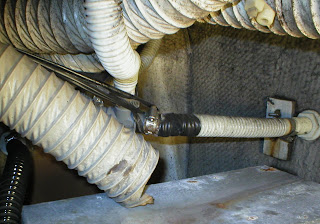The passive ventilation system to the fuel tank and engine spaces is complicated, with lots of 3-inch vinyl dryer hose running from the vents on the sides of the hull to various places. Some of that isn't in good condition and we've replaced sections of it as we went along.
Before we closed the engine hatches and with the work light rigged up, we decided to rehabilitate the scuppers or cockpit drains. There are four scuppers - one at each aft corner of the cockpit and one under the aft corner of each engine hatch. They are designed to catch rainwater or (under very bad conditions) sea water and drain it out through two thru-hull fittings in the transom, just below the swim platform. The drain plumbing was in a pretty sad state and we knew from washing the boat in the fall, that they were probably at least partially clogged and were leaking a lot of the drain water into the bilge
This is how the hoses connecting the starboard scuppers looked before we began the rehabilitation.
The 3-inch vent hose on the left is part of the passive ventilation system that we mentioned above. We relocated that temporarily to get at that the rat's nest of aged electrical tape that was holding the leaky T-fitting connecting the two hoses from the deck above. This area, up under the cockpit liner, is extraordinarily difficult to get to unless you have six-foot arms.
While trying to remove the old hose on the starboard side, we broke off the neck on the thru-hull fitting. Luckily, the marina had one in stock.
Ninety minutes and two bruised knees later, we had properly working starboard scuppers.
That galvanized metal box with the rust stains at the bottom of the photo is the starboard outboard exhaust muffler, a Silverton original. The other three mufflers had been replaced with modern ones when we got the boat.
Then we attacked the port side. The "before" condition was just as bad as the starboard side, so we removed everything and started over with all new 1-1/8-inch hose that is smooth on the inside so it won't catch debris as the old lumpy plastic hose did.
We took this picture by holding the camera at arm's length into the space next to the port side hull, which is at the right. Straight ahead is the transom. Notice how rainwater that drained over the years apparently leaked down the inside of the transom. No wonder. The thru-hull fitting was so loose that we could back off the mounting nut by hand. It's nice and tight now.
Note also the rusty bolts coming through the transom. Those are the mounting bolts for the swim platform, also Silverton original. The backing plates, if you can call them that, are plywood. I guess that's something else that we'll have to replace next winter.
So, one Sunday afternoon and the cockpit will drain properly. The job yielded quite a lot of trash for such a small effort. I wish the PO didn't fix everything with electrical tape.
We'll be out of the engine space soon, but first we need to fix that leak at the water heater. It's a 15-minute job that on a boat takes two hours. Frances has asked for a fresh water spigot somewhere in the cockpit and we'll get that done, also in the next few weeks.
This has been a cold winter but also fun for us.



